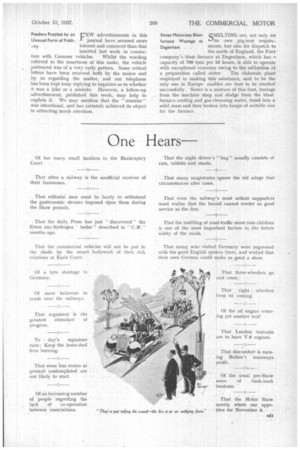Passing Comments
Page 38

Page 39

If you've noticed an error in this article please click here to report it so we can fix it.
Sugar Beet Provides READERS who recall our Road Transport OpI • description of a crop-drying portunities in Norfolk plant in Southacres, Norfolk,
and our reference to the haulage opportunities involved, will be interested to learn that experiments are being carried out to find if the same plant can be used commercially for the drying out of the leaves and crowns of sugar beet. The N.F.U. is guaranteeing a sum of money towards these experiments, and we hope to be able to report again at a later date as to the success achieved.
FARMERS are asking I whether it is to be accepted as a principle that the industrial population shall live at the expense of producers of food in this country and abroad ; that the standard of living in towns shall be raised at the cost of depressing that of agricultural workers, and by decreasing the fertility of our land. It was recently estimated that this country's food bill in 1934 was £1,075,000,000. Despite this, food prices averaged only 22 per cent. above those in July, 1914, 1324.1
Why the Farming
Industry Is Not Pros perous . . . whilst other items in the cost-of-living index were about 72 per cent. higher. The comparison relates to all food consumed and to retail prices. If food costs had risen in proportion the nation would have spent another 4440,000,000. In lieu of this, fartncis here received subsidies amounting to about £15,000,000.
A Matter of Courtesy WHEN we visit foreign at the Paris Motor 'Shows we are usually
Show . . received with courtesy, and facilities are afforded for obtaining inforMation regarding exhibits and for sketching features where this is required. An exception to this was experienced at the Saurer stand at the Paris Salon, where. our artist was rudely ejected after he had half-completed a drawing of some details of a chassis. We explained for what reason the sketch was required, but the official in charge refused to alter his decision. We trust that this incident will come to the notice of the directors of the concern, who may have other views on how representatives of the Press should be treated
FEW advertisements in this journal have aroused more interest and comment than that inserted last week in connec tion with Commer vehicles. Whilst the wording referred to the smartness of this make, the vehicle portrayed was of a very early pattern. Some critical letters have been received both by the maker and by us regarding the matter, and our telephone has been kept busy replying to inquiries as to whether it was a joke or a mistake. However, a follow-up advertisement, published this week, may help to explain it. We may mention that the " mistake " was intentional, and has certainly achieved its object in attracting much attention. Sinter Minimizes BlastSMELTING ore, not only for furnace Wastage at l'•-)its own pig-iron require Dagenham . . . ments, but also for dispatch to the north of England, the Ford' company's blast furnace at Dagenham, which has a capacity of 700 tons per 24 hours, is able to operate with exceptional economy owing to the utilization of a preparation called sinter. The elaborate plant employed in making this substance, said to be the only one in Europe enables ore dust to be smelted successfully Sinter is a mixture of this dust, borings from the machine shop and sludge from the blast furnace cooling and gas-cleansing water, fused into a solid mass and then broken into lumps of suitable size for the furnace.




































































































